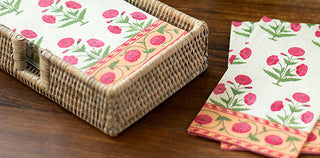At Caspari, we seek out artwork to publish on our products in a wide variety of places. One medium we love to explore is textile design! Some of the most beautiful patterns can be found in traditionally printed textiles and hand-woven fabrics. From the vibrant colors to the meticulous craftsmanship, the opportunities for inspiration are immense. Here, we’ll focus on some of the textile design practices used in India.
Archeological evidence shows a cotton textile industry in India from as far back as 3000 B.C. During the ancient and medieval times, textile weaving depended on the preferences of those in political power. Artistically minded rulers usually let the practice flourish.
Starting in 1597, Dutch and English ships sailed to India to exchange bullion for cotton textiles. And as Indian textiles became more well-known around the world, people became more familiar with and appreciative of different designs. Jaipur block printing, for example, involves pressing hand-chiseled printing blocks into fabrics after they are dipped into dye. Each block is incredibly intricate, and the creators use a teak tracing to guide their carving efforts.
There’s also Ikat, a process of weaving a design into fabric by tying or binding threads together. The craftspersons often select contrasting hues for maximum visual impact, while focusing on making repetitive patterns for a polished look. The craft is practiced in Japan and Indonesia, as well as India.
Embroidery features prominently in Indian textile designs, too. People attach floss silk to cotton with a darning stitch, usually choosing colorful silk. A specific technique called Phulkari (flower work) involves crafters choosing floral designs for embroidery. They don’t stop there, however. Motifs and geometric shapes fall under the Phulkari umbrella too.
Incorporating these beautiful textile designs into your table settings adds a beautiful touch and reflects these time-honored artisan technics. Amala Ikat, for example, is a pattern we adapted, which was originally a textile design painted on silk. Our designers created a variety of color options for this design, making it easy to find a hue that matches your setting.
For a bolder block-printed style, you may consider Indian Poppy. This design came from Boston’s Museum of Fine Arts textile collection. We discovered it on a cotton floor cover painted and resist-dyed to achieve the desired effects. The piece was from the late 17th century or early 18th century, and our version of the design beautifully illustrates the bright colors and nature-inspired motifs that Indian weavers often use.
India’s textile specialists take tremendous pride in their work and pass their knowledge down to family members. You can celebrate that commitment to the craft by bringing some products from these prints into your home.
Sources:
http://char.txa.cornell.edu/IndianTex.htm
https://www.nytimes.com/2018/05/18/t-magazine/block-print-jaipur-india.html







